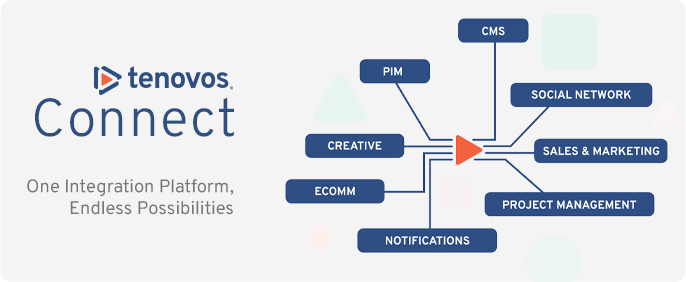
In the summer of 1992, the United States glided to a gold medal victory on the pure skill of their men’s Olympic basketball team, nicknamed the “Dream Team.” It featured a stacked list of professional NBA players like Magic Johnson, Charles Barkley, Michael Jordan, and Larry Bird—to this day, it’s considered the greatest sports team ever assembled. The key to their success was selecting the best-of-the-best players for the right positions at the right time, each playing to their strengths.
When it comes to assembling a dream team, Kristina Huddart, Digital Asset Management (DAM) Specialist and Consultant, knows what it takes. In this article, she coaches us on how to create the kind of DAM dream team that wins gold—from the start of your digital asset management journey all the way through to optimizing your DAM and realizing its full value.
A DAM dream team consists of many people from inside and outside the organization, and Kristina’s breadth of knowledge will guide you through all their roles and what they can contribute. Plus, stick around until the end for a list of common DAM mistakes and Kristina’s advice on recruiting.

Building Your DAM Dream Team in Four Phases
When you’re beginning your DAM journey, the dream team is just a twinkle in your business sponsor’s eye. The business sponsor is the high-level employee—often a leader from marketing or IT—who is in meetings with the executive team discussing the objectives of the organization. They kick-start this journey by asking the right questions:
- Do we have the tools, resources, and people to create immersive digital experiences?
- Are we reaching our business objectives in marketing?
- How can we get all our retail products to be available through ecommerce sites?
The business sponsor is usually the first one to consider a DAM as a potential solution and they are the catalyst for garnering support from the executive team to resource and invest in the entire DAM journey.
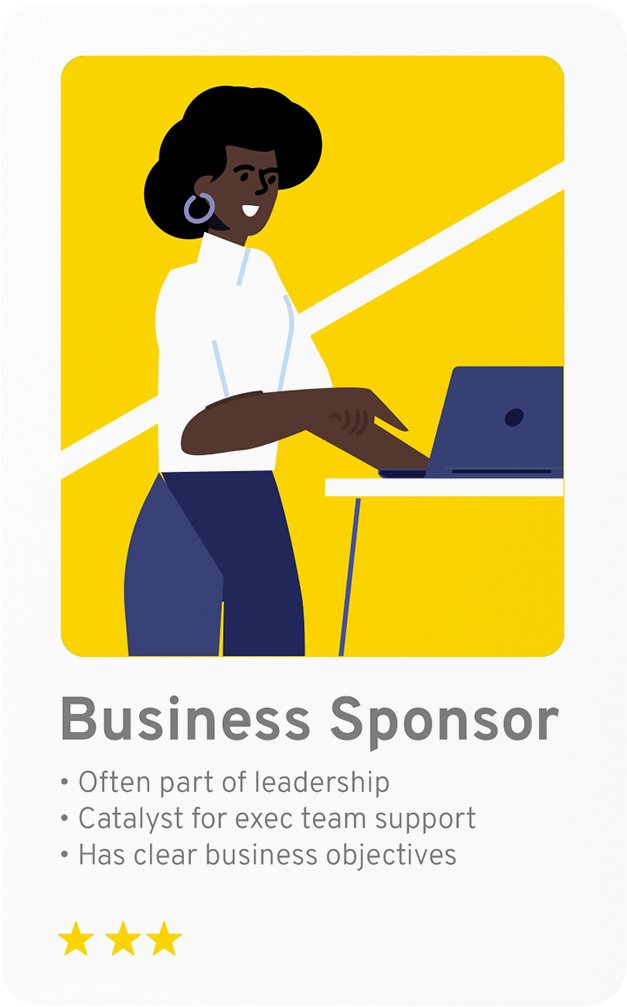
But the business sponsor only partly knows the needs of the organization. In order to assess how to best achieve their objectives, they invite the business analyst to investigate. The business analyst is usually a team member shared from IT who will begin the conversation with stakeholders in solving challenges set out by the business sponsor. The analyst talks with people across the organization to get to the heart of their pain points and priorities. Through these conversations, they compile a list of requirements and needs that the DAM solution should address.
This list prioritizes needs like robust metadata features and artificial intelligence. Or how the governance structures should be set up to ensure review workflows are more organized than they are currently. It’s important that the business analyst’s tasks are done early and with great attention to detail. The list of requirements they create sets the foundation for the rest of the DAM journey.
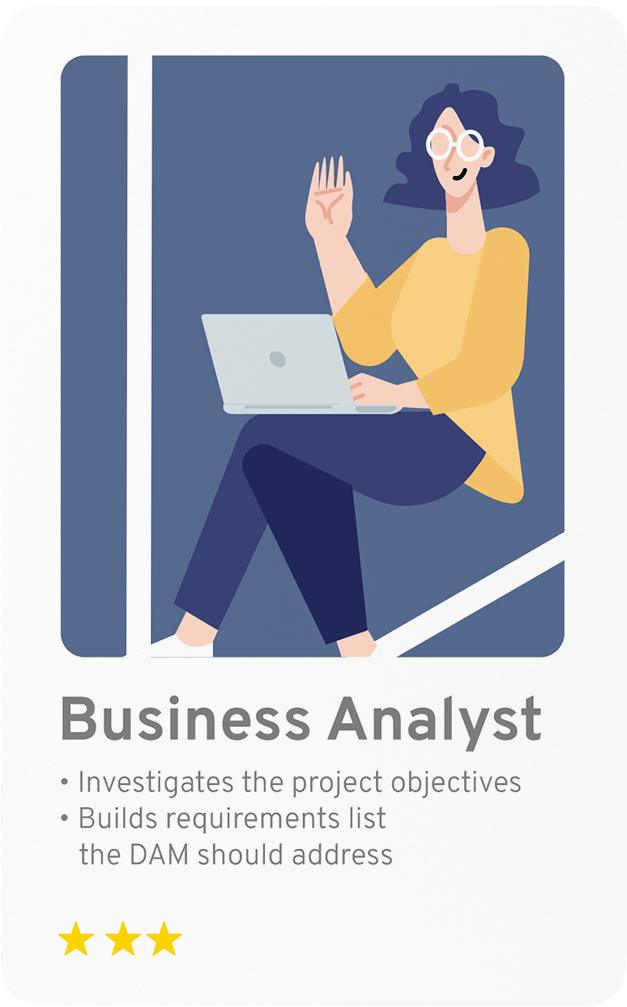
It’s at this point in your dream team draft pick that you recruit your DAM manager—your MVP. But as Kristina knows all too well, recruiting can pose some challenges.
“The reality is that most companies don’t get a DAM manager until much further down the road,” she says. “But the benefit of having them start early is so they can get up to speed and drive the process. Whether you’re hiring from within the business or externally, they may or may not have expert DAM-specific experience. So getting them started right away and familiar with the requirements and specific business objectives from the business analyst is key.”
The more consistency in your MVP, the better your DAM dream team will play together.
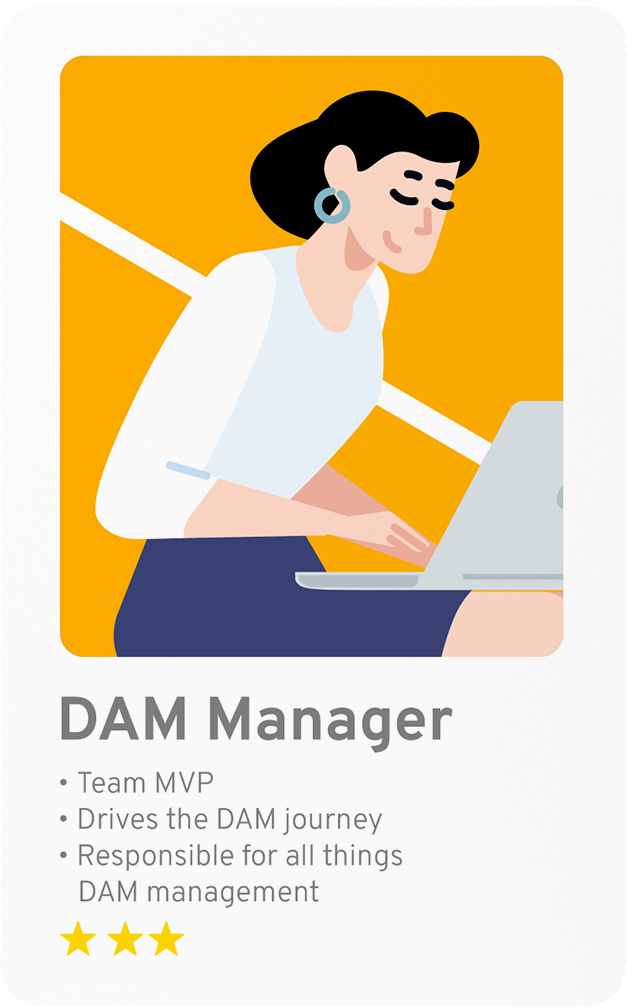
“The more consistency in your MVP, the better your DAM dream team will play together.”
– Kristina Huddart
They don’t need expert DAM knowledge right away—especially if you hire from within marketing, IT, or the digital web content team—but they will be the person driving the DAM journey from phase one onwards.
That’s why the support from an external DAM specialist is next on the roster. As an external temporary consultant, the DAM specialist offers expert knowledge on the industry.
“With my clients, I help them with the DAM selection and implementation process,” Kristina says. “That includes beginning to train, onboard, and share knowledge with that new DAM manager so they hit the ground running.”
The DAM specialist is a coach to your dream team. They offer industry-specific training, proof of concept for your leadership team, and pre-implementation support with your DAM.
Most importantly, they help set the vision for the DAM journey. If your business sponsor is the first one to notice your pain points, and your business analyst begins to define them, your DAM specialist finds the solutions. Kristina’s job is to help the DAM dream team build metadata, governance, and taxonomy structures well before they select a DAM system.
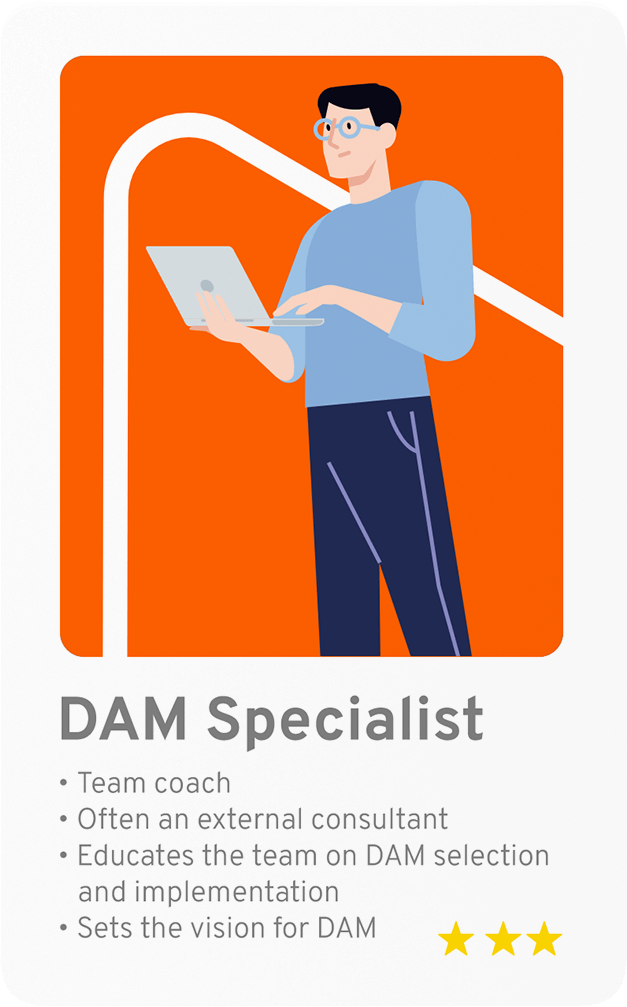
“Your specialist also sits down with your stakeholders to find their ideal workflows. Because the clunky 40-step workflow you have today can’t be dropped into your shiny new piece of tech,” she says. Together with the DAM manager and business analyst, the DAM specialist takes the list of requirements and the ideal vision for the DAM and offers their recommendations from a range of fit-for-purpose DAM vendors.
The DAM vendor is the partner to the DAM dream team. The relationship between the dream team and vendor is probably the most important, which is why choosing the right vendor with the support of your DAM specialist is imperative.
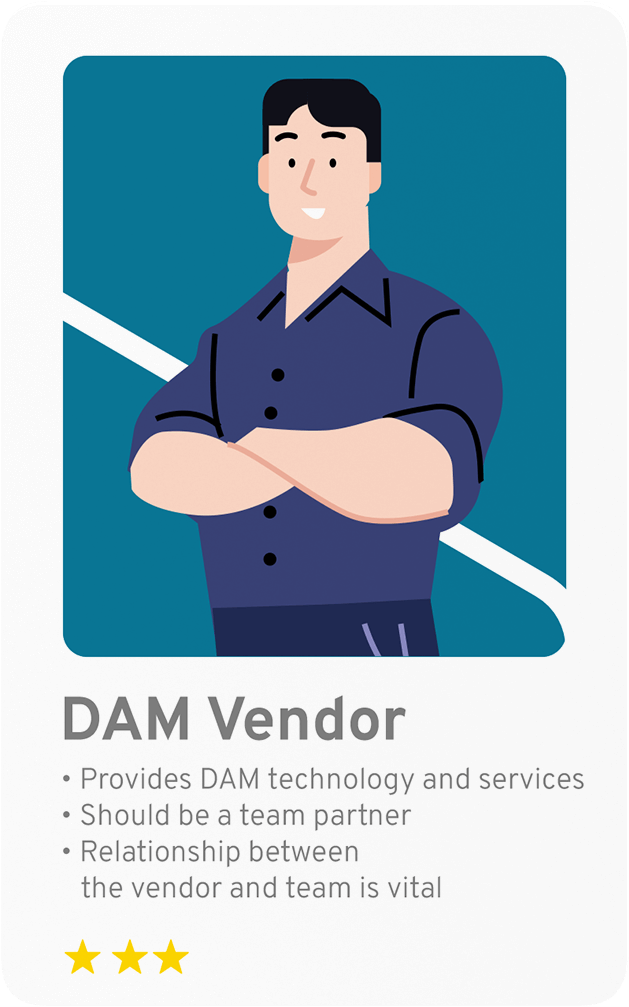
The DAM manager will be in ongoing contact with the vendor discussing new use cases, troubleshooting issues, and seeking technical support. The DAM vendor will also recommend a DAM integration partner to support the various integrations between your new DAM and your existing tech stack that happen in phases two and three.
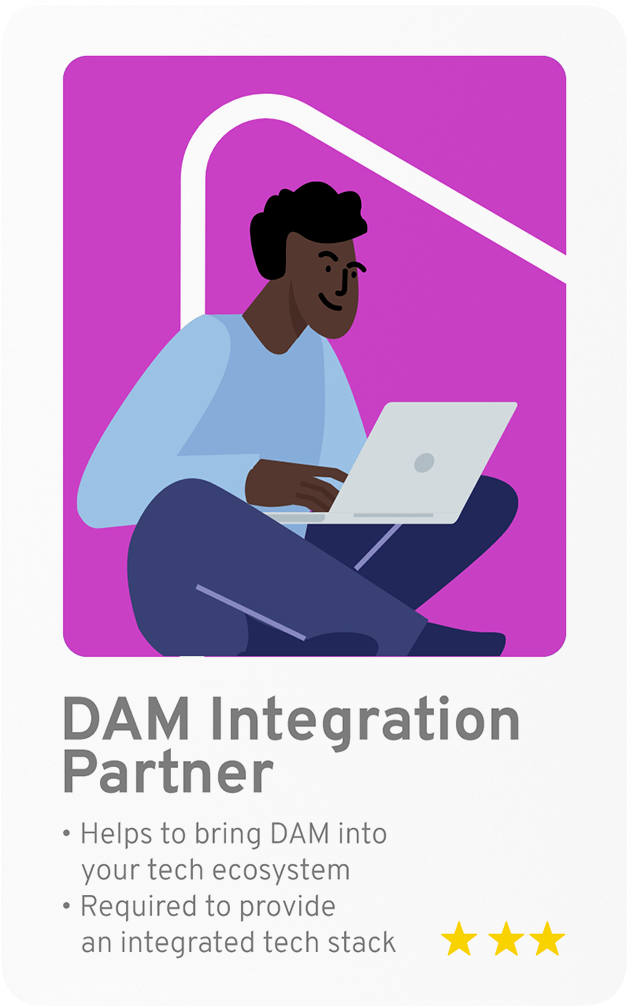
Phase Two: Developing the Foundations
So, you’re about to launch your DAM system. The business sponsor is getting the executive team excited. The business analyst and DAM specialist are hosting therapy sessions with your potential users.
“Your stakeholders are tired of looking for assets in hidden folders and manually managing assets. This is the phase where you can assure them the business is investing in new technologies to support them and make their jobs easier. The DAM will free them to achieve their objectives and do the things they love, like being creative or building amazing content for the website,” Kristina explains.
In many ways, the job of the DAM manager is to wrangle all these moving pieces while taking on the role of change manager (although, a dedicated change manger would be ideal). If your business is putting in all the resources and time to implement this DAM, you want people to use it. “The end goal is to have the maximum number of users in the DAM regularly. Ideally, they love it so much they’re telling all of their colleagues about how useful and time-saving it is,” Kristina says. Change management starts as early as phase one with the business sponsor and continues through the DAM journey. The key to DAM user adoption is to create a network of DAMbassadors—the evangelists of the DAM who will be your cheerleaders and representatives through the process.
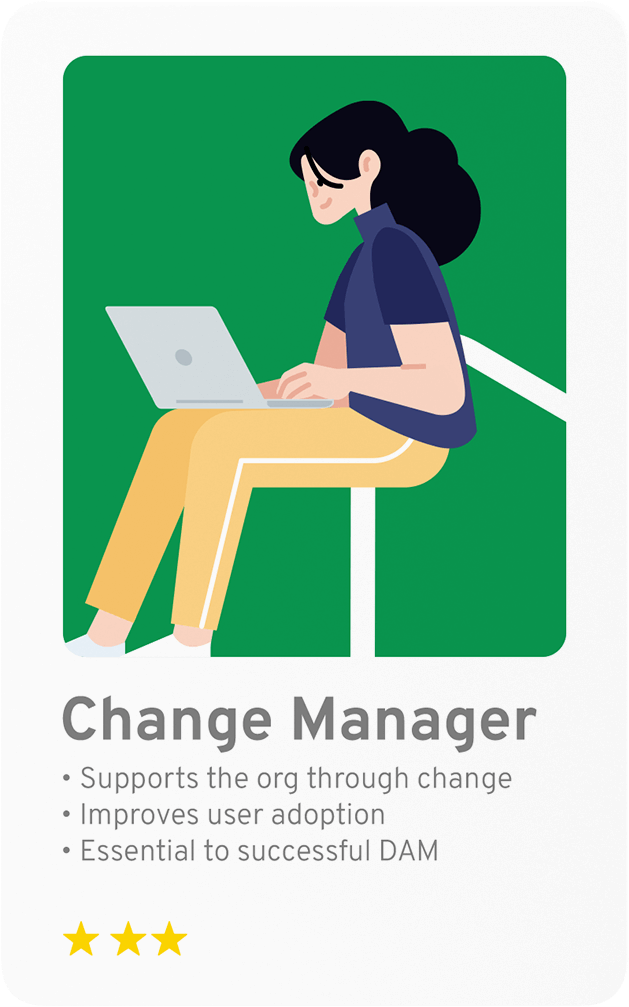
In phase two, the IT information architect also joins the DAM dream team. They are usually an internal team member (they could even be the same as your business analyst) who can validate your tech stack needs and integrations to ensure everything works as designed. They will set up single sign-on, handle technical hurdles in implementation, build helpful documentation, and manage security certificates. These internal tech supports will not be something your DAM specialist (or DAM implementation specialist, a consultant that specializes in DAM implementation, often the same as your DAM specialist) can manage in your backend, so you’ll need support from IT.
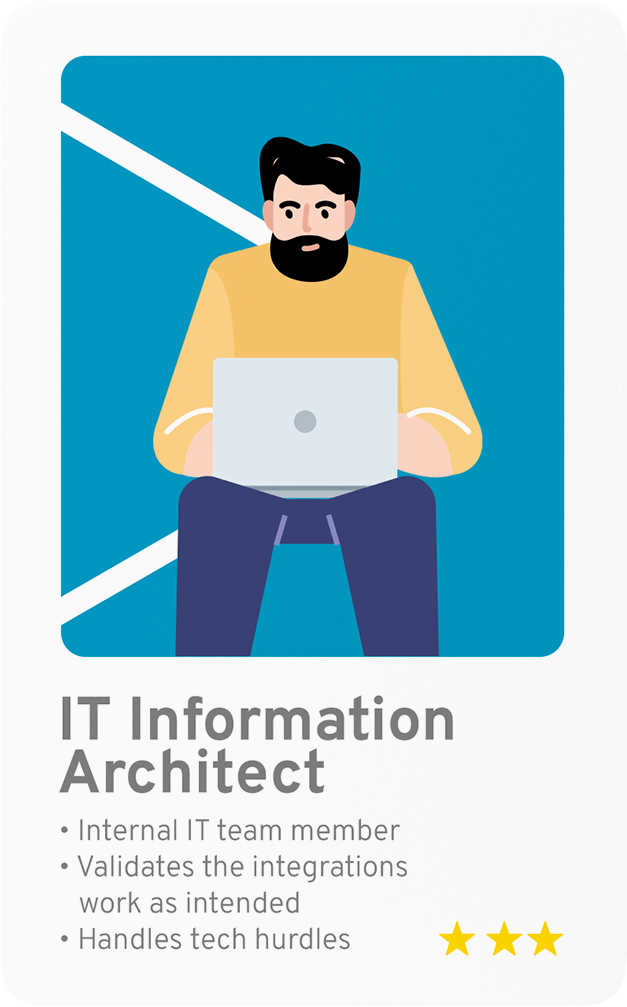








Phase Three: Building Maturity and Standardizing Operations
Hopefully, your dream team is running hard in the paint. Kristina says, “If you’re lucky enough to have IT and operations in-house, phase three is for continuing to standardize your DAM processes. Even if your DAM is up and running, it shouldn’t be operating as an island. It should be connected to your other systems.” This will require the support of your IT information architect and DAM integration partner to help you manage the technical issues that arise as you ensure your data moves seamlessly through your connected systems.
In this phase, you may also add a DAM coordinator to assist your DAM manager in continually improving the DAM, supporting stakeholders, and checking the quality of the content coming into the system. You may even consider outsourcing some of your DAM management to external organizations who provide DAM as a managed service. You’ll spend the majority of your time managing, improving, and utilizing the DAM in this phase. The DAM manager may invite the change manager or DAM specialist back in this stage to support refining processes, building better workflows, or strategizing DAM adoption.
Phase Four: Optimizing and Realizing Full Value
You can’t be in your prime forever—it’s three or four years into your DAM journey and you may have a different business sponsor or DAM manager. Entropy has set into certain areas of the DAM and users are beginning to complain about lost assets and confusing metadata. “I see this happen all the time,” Kristina says, “All it takes is a few issues—a business is between DAM managers and users upload 10,000 assets without metadata or the manager isn’t aware that their DAM has video capabilities for their new use cases.” This is a perfect time to invite the DAM specialist back for a health check on how the DAM is functioning.
In phase four, the DAM specialist’s diagnosis will consist of assessing people, process, tech, and data—what is the current state of the team and what can we do to get on track?
“Each time I do a health check on a DAM, the business will come to me with the assumption that they need a new system,” Kristina explains, “But often there are many things the DAM team can do that do not require a replacement of your existing DAM.” By understanding the maturity of the business, how the DAM is currently managed, and where the business wants to take it moving forward, the DAM specialist can help the DAM dream team optimize those areas and get everyone playing at their best again.
How Do You Do It? Four Frequently Asked Questions For Creating Your DAM Dream Team
1 – Should I recruit people from within my organization to be involved in the DAM?
Kristina: Yes! Beg, borrow, and (kindly) steal them from within your company. Most people will not work within the DAM full time, but they are still an important part of planning, implementing, and running the DAM. Determine how much of each person’s time should be spent on the DAM and ensure that all stakeholders are on board with their commitment to making the DAM the best it can be. You can recruit your DAM manager from within your business, just make sure they’re dedicated to spending 100 percent of their time on the DAM.
And consider recruiting support from across the organization. The times when I’ve seen things go wrong are when the DAM team is too focused on the marketing department and isn’t taking into consideration the needs of other teams. You need a network of people across the whole organization who are supporting the DAM, using it regularly, and contributing to improving it over time.
2 – What are the mistakes you see over and over when businesses are building a DAM dream team?
Kristina: There are two major mistakes businesses make over and over. Managing business sponsor turnover and choosing a ‘project management model’ for their DAM implementation. I’ll explain both in detail.
Business sponsor turnover—Typically, the business sponsor was the person at the beginning who chose to investigate a DAM solution, advocated for resources, and got buy-in from executive staff. When a new person enters that role, they may not be aware of their role in stewarding this process, and I’ve seen DAM management go awry or get defunded in those situations.
My advice is to get your business sponsor educated about the DAM and how their role is critical to its success as soon as possible. They don’t need experience with digital asset management but they need to understand how they can support the DAM team with resources, investment, and advocacy. They may even come in with new and exciting ways to improve the DAM—so don’t let that opportunity slip away.
Implementing your DAM with a project management model—Sometimes, in place of a DAM manager, companies will start out with a project management team to implement the DAM system. The issue with this approach is that a project management team is usually a technical team. They’re not implementing a thoughtful change management process.
So even if the DAM is launched quickly, when the project management team is dissolved, things will go wrong pretty quickly without a dedicated DAM manager. You have a new tool without anyone knowledgeable on how to use it or internal staff to support it. My advice is to avoid this model of implementation because it quickly turns your DAM into a dumping ground.
3 – We can’t afford a dream team! If it had to be pared down to the essentials, who is non-negotiable?
Kristina: Your absolute need-to-have DAM team is:
Business sponsor—Without the business sponsor—the DAM’s cheerleader to the executive staff—the DAM manager won’t be able to do much. Their support is essential.
DAM manager—A full-time DAM manager is the only way to run a successful DAM. And I do say dedicated because this isn’t a side project. I often think about a DAM like a website. You’re not going to throw a website at a developer and say, “Build us a website in 20 percent of your time. Keep doing the rest of your day job and once it’s built, you’re done.” That’s not how DAM works either.
DAM specialist—It’s unlikely that your business is going to have the expert knowledge of the entire DAM marketplace. Have a DAM specialist provide expertise and give that strategic direction when you need it. My role as DAM specialist is actually to work myself out of a job—I share knowledge, do training, offer best practices, and set things up for success. Then the DAM team takes it from there.
”DAM isn’t a side project.”
– Kristina Huddart
4 – What does the business stand to lose without a DAM dream team?
Kristina: It’s going to be hard to achieve the return on investment you want without having the right resources, the right skills, and the right people. Without that, you’ve got a very expensive piece of tech and nobody uses it. There’s a lot to lose.
Get the right people in place in phase one to avoid implementation delays. The last thing you want is a false start or endless DAM tech hurdles. DAMs are not cheap and most companies don’t have the luxury of getting it wrong. Get the right resourcing support and the right people on your team. You won’t regret getting it right on your first shot.
Gold Medals All Around
The key to the success of the U.S. Olympic basketball team was the skillful assembly of the best players in their prime, playing to their strengths together as a team. Your DAM dream team is no different. A DAM dream team consists of specialists, managers, IT folks, and vendors from inside and outside the organization who pool their individual skills to contribute to the success of the DAM. If you can assemble the best players from inside and outside your business, you’re headed for nothing but gold medals across the board.
Kristina Huddart is a Digital Asset Management Specialist and Consultant. She helps businesses of all sizes support their marketing teams to work more efficiently with digital tools, organize and leverage the flood of valuable content, and achieve operational efficiencies. Kristina works with the right people to improve and optimize processes happening in the business, and helps with implementing and rolling out the right technologies.
You can connect with her via her website: https://huddartconsulting.com/


